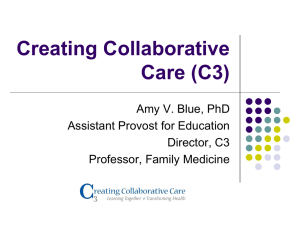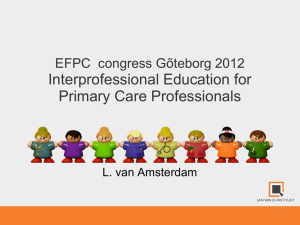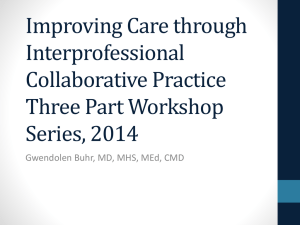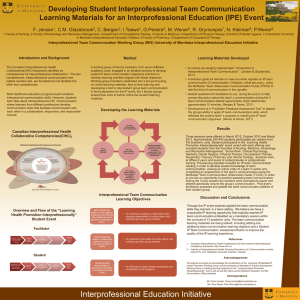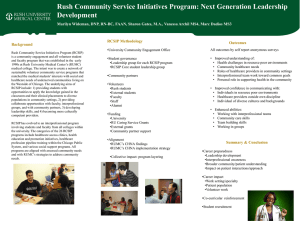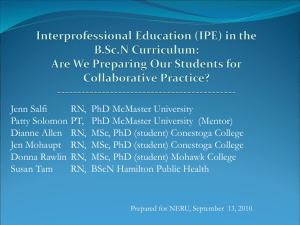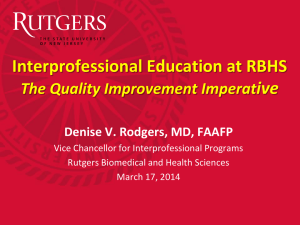Hugh Barr presentation
advertisement
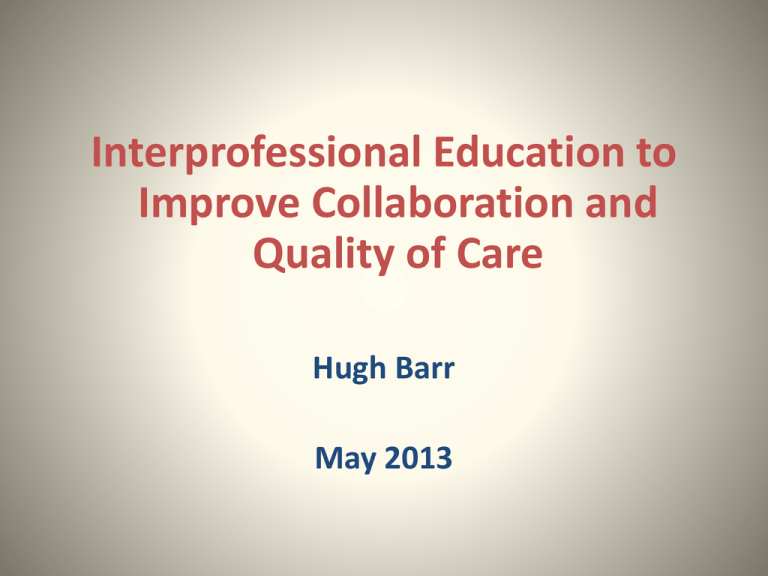
Interprofessional Education to Improve Collaboration and Quality of Care Hugh Barr May 2013 Multiprofessional Education Interprofessional Education Multiprofessional Education Occasions when professions learn side by side Interprofessional Education Occasions when professions learn with, from, and about each other, to improve collaboration and the quality of care Interprofessional Education Expectations Outcomes Evidence Five Expectations • • • • • Repairing relationships Developing teamwork Improving care & services Safeguarding patients Deploying human resources optimally Relationships Improvement Teamwork Safety Workforce Relationships Improvement Teamwork Safety Workforce Relationships Improvement Teamwork Safety Workforce Relationships Improvement Teamwork Safety Workforce Relationships Improvement Teamwork Safety Workforce Relationships Improvement Teamwork Safety Workforce Formulating Outcomes United Kingdom: Sheffield Hallam University (2010) Interprofessional Capability Framework. Mini-guide Canada: Canadian Interprofessional Health Collaborative (2010) A national competency framework for interprofessional collaboration. United States: Interprofessional Education Collaborative Expert Panel (2011) Core competencies for interprofessional collaborative practice: report of an expert panel. Washington D.C.: Interprofessional collaborative A Digest Curtin University Interprofessional Capability Framework Brewer & Jones, 2013 http://healthsciences.curtin.edu.au/faculty/ipe_publicati ons.cfm Assembling the Evidence • Evidence from whom? • Evidence of what? Triangulating the evidence base for IPE External Evaluative Research External Approval & Review Internal Approval & Review Commissioning & Monitoring IPE Programme The Naïve Question • Does IPE Work? The Smart Question What types of IPE under what conditions result in what types of outcome? Systematic Reviews 1 Cochrane: Reeves, S., Zwarenstein, M., Goldman, J., Barr, H., Freeth, D., Hammick, M. & Koppel, I. (2011) Interprofessional education: effects on professional practice and health care outcomes. The Cochrane Database of Systematic Reviews Systematic Reviews 2 • Barr, H., Koppel, I., Reeves, S., Hammick, M. and Freeth, D. (August 2005) Effective Interprofessional Education: Argument, Assumption and Evidence. Oxford: Blackwell • Hammick, M., Freeth, D., Reeves, S., Koppel, I., & Barr, H. (2007). A best evidence systematic review of interprofessional education. Dundee: Best Evidence Medical Education. Guide no. 9. Medical Teacher 29, 735-751. JET The Interprofessional Education Joint Evaluation Team Modified Kirkpatrick Scale Level 1 – Reaction Learners’ views on the learning experience and its interprofessional nature. Level 2a – Modification of attitudes / perceptions Changes in reciprocal attitudes or perceptions between participant groups. Changes in perception or attitude towards the value and/or use of team approaches to caring for a specific client group. Level 2b - Acquisition of knowledge/skills Including knowledge and skills linked to interprofessional collaboration. Level 3 - Behavioural change Identifies individuals’ transfer of interprofessional learning to their practice setting and their changed professional practice. Level 4a – Change in organisational practice Wider changes in the organisation and delivery of care. Level 4b – Benefits to patients/clients Improvements in health or well being of patients/ clients.
